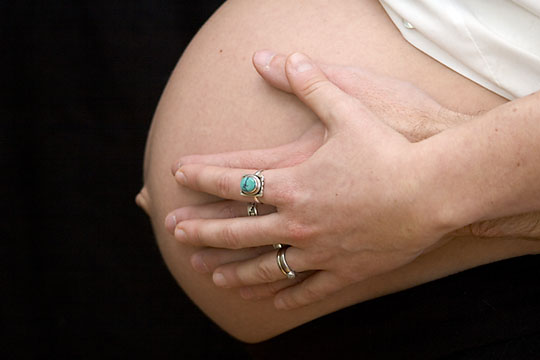Oh, the pressures of being pregnant! So many people telling you what to do. Eat this, not that! Don't worry about weight gain. Worry about weight gain. Worrying about weight gain will give your baby anxiety. Ahhhh! It can be so overwhelming at times. Thankfully, there are many things that pregnant women can do to reduce their exposure to environmental toxins.
MomsRising partnered with the Reproductive Health Technologies Project this past week for our weekly tweet chat called #EcoTipTue. Sara Alcid was our special guest and she shared lots of important information for pregnant women, their partners, caregivers, health advocates, and fans. Reproductive Health Technologies advocates for chemical policy reform so the burden of protection doesn’t have to be on pregnant women.
Environmental toxins are a growing concern in the medical community. The American College of Obstetricians and Gynecologists released a new study calling for policy action to protect pregnant women, infants and children, and encouraging physicians to make environmental toxic chemical risk, exposure and guidance part of their care. Why? Because every pregnant woman in U.S. is exposed to at least 43 different toxic chemicals, and many can pass from a pregnant woman to her fetus. Preconception and prenatal exposure to toxic chemicals can have a profound and lasting effect on health across a lifetime.
Here are 10 ways you can limit toxic chemical exposures while you are pregnant.
1. Start early. Exposure to toxics before pregnancy can impact fetal health. If are you reading this and have no current plans for having children, or hope to down the road, the time is now to limit your exposure so you can protect your reproductive health options.
2. Eat organic food as much as possible to avoid pesticide residue. If this is not possible, eat only the Clean 15 and avoid the Dirty Dozen.
3. Don't microwave plastic or put it in the dishwasher. Endocrine (hormone) disrupting chemicals leech out of plastic at elevated temperatures. Endocrine disrupters swamp a developing fetus, with potentially long term implications. They have been linked to reproductive problems, early puberty, cancer, and obesity.
4. Avoid using conventional feminine products. They contain harmful chemicals and the vaginal absorbs many more chemicals than other tissue. Find out the most toxic products and ingredients to avoid and reduce use as much as possible. Look for unscented and unbleached products from companies that list all of their ingredients.
5. Remove your shoes (and kindly ask your guests to as well) before entering your home to avoid tracking in oils and chemicals from the street. This is an easy, painless step that can reduce exposures!
6. Use fewer personal products (such as cosmetics, lotions, hair and nail products). Many ingredients have been linked to health problems and add to the chemical cocktail of exposure. Personal care products are unregulated. Companies can use whatever chemicals they want in products until they are proved harmful or the public pressure gets too great. That's why we need chemical policy reform! Products need to be proven safe BEFORE they hit the market.
The personal care products you do use, try to make sure they have no synthetic fragrances, parabens, phthalates, or triclosan. Find out how your favorite products rate (and get the new app to use in stores!). Buy and use safer products.
7. Avoid conventional household cleaners that contain toxic ingredients such as drain, toilet and oven cleaners. According to Planned Parenthood, "Some cleaning products can disrupt your hormones, which can change the start of puberty in young teens. If you’re a woman, disrupted hormones may make it harder to get pregnant, change your menstrual cycle, and increase your risk of miscarriage and breast cancer. If you’re a man, disrupted hormones may lower your sperm count and increase your risk of testicular cancer." Many reasons to avoid these toxic cleaners! Find safer ones such as Seventh Generation or make your own.
8. When selecting a midwife or ob/gyn, ask about environmental toxin and chemical exposures. Consider their response in your decision making. According to Reproductive Health Technologies Project, caregivers should perform an exposure history/inventory to assess exposure that has already occurred and after the assessment, patient-centered actions can be developed with the provider to reduce body burdens of toxic chemicals. Here are resources for you and your care provider.
9. Ditch the non-stick cookware. Most is laden with PFOA chemicals, which have been linked to infertility, thyroid disease, and are a likely carcinogen. Use stainless steel or cast iron instead. Many ompanies are phasing it out-- but don't have to until 2015.
10. Last and most important! Advocate for strong toxic chemical policy that protects pregnant women, babies and children from the many harmful toxins in our products, food and homes. Join MomsRising and join Safe Chemicals, Healthy Families, Breast Cancer Fund, Women's Voice for the Earth, Environmental Working Group, organizations all working to strengthen proposed legislation to protect families from toxic exposures.
Congratulations and remember to take one day at a time doing the best that you can. We'll keep calling for better regulation and advocating on behalf of pregnant women everywhere.



The views and opinions expressed in this post are those of the author(s) and do not necessarily reflect those of MomsRising.org.
MomsRising.org strongly encourages our readers to post comments in response to blog posts. We value diversity of opinions and perspectives. Our goals for this space are to be educational, thought-provoking, and respectful. So we actively moderate comments and we reserve the right to edit or remove comments that undermine these goals. Thanks!